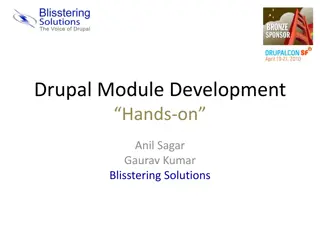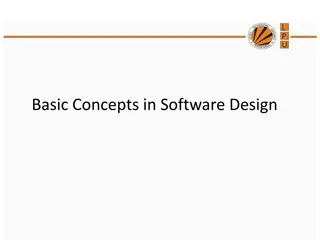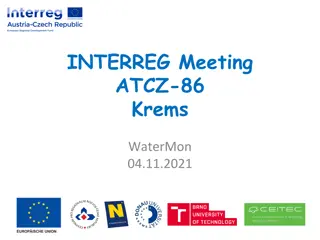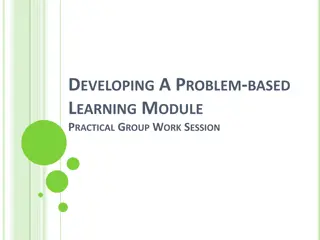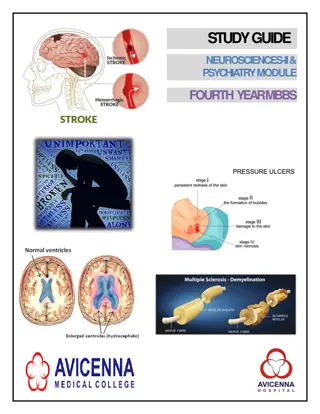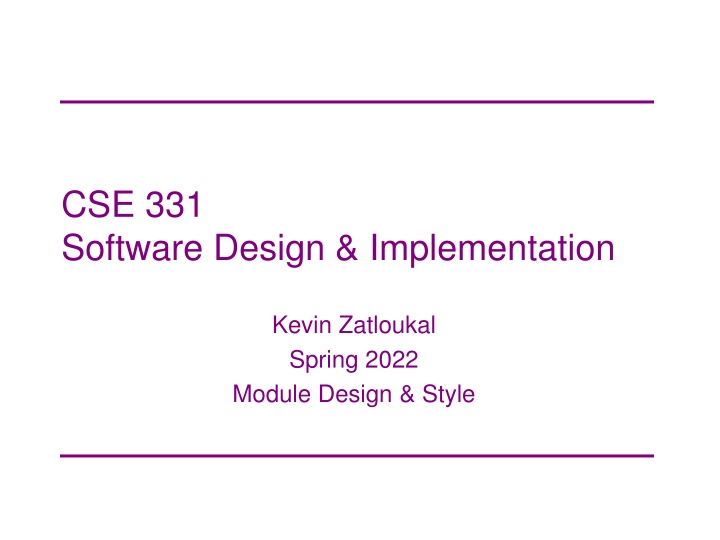
Modular Software Design and Implementation
Discover the importance of modular software design in CSE 331 with a focus on scaling limitations, goals of modularity, design issues like coupling and cohesion, and the common design objective of separation of concerns. Learn how breaking down software into manageable modules can enhance development and maintenance efficiency.
Download Presentation

Please find below an Image/Link to download the presentation.
The content on the website is provided AS IS for your information and personal use only. It may not be sold, licensed, or shared on other websites without obtaining consent from the author. If you encounter any issues during the download, it is possible that the publisher has removed the file from their server.
You are allowed to download the files provided on this website for personal or commercial use, subject to the condition that they are used lawfully. All files are the property of their respective owners.
The content on the website is provided AS IS for your information and personal use only. It may not be sold, licensed, or shared on other websites without obtaining consent from the author.
E N D
Presentation Transcript
CSE 331 Software Design & Implementation Kevin Zatloukal Spring 2022 Module Design & Style
The limits of scaling Can t built arbitrarily large physical structures that work perfectly and indefinitely friction, gravity, wear-and-tear Software has no such problems! So what prevents arbitrarily large software? it s the difficulty of understanding it! The force of friction is replaced by a force in software that creates interdependence( coupling ) between different parts of the code in particular, this force makes it hard to understand one part of the code without understanding many other parts CSE 331 Spring 2022 2
The limits of scaling Can t built arbitrarily large physical structures that work perfectly and indefinitely friction, gravity, wear-and-tear Software has no such problems! So what prevents arbitrarily large software? it s the difficulty of understanding it! We make software easier to understand by breaking it into pieces that can be understood (and built) separately using modularity CSE 331 Spring 2022 3
Many goals of modular software... Decomposable can be broken down into modules to reduce complexity and allow teamwork Composable Having divided to conquer, we must reunite to rule [M. Jackson]. Understandable one module can be examined, reasoned about, & developed in isolation Continuity a small change in the requirements should affect a small number of modules Isolation an error in one module should be as contained as possible CSE 331 Spring 2022 4
Most important design issues Coupling how much dependency there is between components want to understand each component without (much) understanding of the others Cohesion how well parts of a component fit and work together form something that is self-contained, independent, and with a single, well-defined purpose Goals: decrease coupling, increase cohesion Applies to modules and smaller units each method should do one thing well each module should provide a single abstraction CSE 331 Spring 2022 5
Cohesion The common design objective, separation of concerns, suggests a module should represent a single concept a common kind of concept is an ADT If a module implements more than one abstraction, consider breaking it into separate modules for each one CSE 331 Spring 2022 6
Coupling How are modules dependent on one another? statically (in the code)? dynamically (at run-time)? for us: do we need to understand one to understand the other? ideally, split design into parts with little interdependency MY MY MY FINAL PROJECT PROJECT FINECT PROJAL FINAL A poor decomposition (parts strongly coupled) A better decomposition (parts weakly coupled) An application The more coupled modules are, the more they need to be thought about all at the same time in order to be understood CSE 331 Spring 2022 7
Coupling leads to Spaghetti Code Coupling induces more and more coupling eventually turning into spaghetti code Lacks all the properties of high quality code hard to understand hard to change hard to make correct Can be necessary to throw away the code and start over CSE 331 Spring 2022 8
God classes god class: hoards most of the data or functionality of a system depends on and is depended on by every other module poor cohesion little thought about why all the elements are placed together reduces coupling but only by collapsing multiple modules into one (which replaces dependences between modules with dependences within a module) A god class is an example of an anti-pattern a known bad way of doing things CSE 331 Spring 2022 9
Class design ideals Cohesion and coupling, already discussed Completeness: should every class present a complete interface? good advice for public libraries for other code, better to avoid unnecessary work can leave TODOs for what you want to add later or have methods that throw RuntimeException( not yet implemented ) Consistency: in names, param/returns, ordering, and behavior (more later...) CSE 331 Spring 2022 11
Class Cohesion Examples Confine user interaction to a core set of view classes and isolate these from the classes that maintain the key system data see HW7-9 Do not put print statements in your core classes this locks your code into a text representation makes it less useful if the client wants a GUI, a web app, etc. Instead, have your core classes return data that can be displayed by the view classes which of the following is better? public void printMyself() public String toString() CSE 331 Spring 2022 12
Method Cohesion Methods should do one thing well: compute a value but let client decide what to do with it don t print as a side effect of some other operation observe or mutate, don t do both Having a method do multiple, not-necessarily-related things limits future possible uses Flag variables are often a symptom of poor method cohesion often mean the method is doing multiple things CSE 331 Spring 2022 13
Method design Effective Java (EJ) Tip: Design method signatures carefully avoid long parameter lists especially error-prone if parameters are all the same type avoid methods that take lots of Boolean flag parameters Which of these has a bug? memset(ptr, size, 0); memset(ptr, 0, size); EJ Tip: Use overloading judiciously Can be useful, but avoid overloading with same number of parameters, and think about whether methods really are related CSE 331 Spring 2022 14
Consistency A class or interface should have consistent names, parameters/returns, ordering, and behavior Use similar naming; accept parameters in the same order Counterexamples: setFirst(int index, String value) setLast(String value, int index) Date/GregorianCalendar use 0-based months Stringmethods: equalsIgnoreCase, compareToIgnoreCase; but regionMatches(boolean ignoreCase) String.length(), array.length, collection.size() CSE 331 Spring 2022 15
Constructor design Constructors should have all the arguments necessary to initialize the object's state no more, no less Object should be completely initialized after constructor is done (i.e., the rep invariant should hold) Shouldn't need to call other methods to finish initialization sometimes tempting but an easy way to cause bugs complex initialization can be done using a builder pattern (more on this in later in the course) CSE 331 Spring 2022 16
Field design A variable should be made into a field if and only if: it has a value that retains meaning throughout the object's life its state must persist past the end of any one public method All other variables can and should be local to the methods fields should not be used to avoid parameter passing not every constructor parameter needs to be a field Exception to the rule: when we don t control the interface example: Thread.run CSE 331 Spring 2022 17
Choosing types some hints Numbers: favor int and long for most numeric computations EJ Tip: avoid float / double if exact answers are required Classic example: money (round-off is bad here) Strings are often used since much data is read as text, but keeping numbers as strings is a bad idea. CSE 331 Spring 2022 18
Enums make code more readable Consider use of enums, even with only two values which of the following is better? oven.setTemp(97, true); oven.setTemp(97, Temperature.CELSIUS); CSE 331 Spring 2022 19
Last thoughts (for now) Always remember your reader and add comments for them Who are they? Clients of your code Other programmers working with the code (including yourself in 6 weeks/months/years) What do they need to know? How to use it (clients) How it works, but more important, why it was done this way (implementers) Think about mistakes that might be made (by you or others) if you have enough clients, someone will make that mistake design to prevent or at least catch those mistakes pay special attention to bugs that will be hard to detect CSE 331 Spring 2022 20
Naming Choosing good names is important for readability With well chosen names, code can be self-documenting no need to include comments with explanation code explains itself CSE 331 Spring 2022 22
Bad names flag, status, compute, check, pointer, names starting with my convey very little useful information! (count is okay if meaning is very clear from context) Describe what is being counted, what the flag indicates, etc. numStudents, courseIsFull, calculatePayroll, validateWebForm, (methods) (fields) But short names in local contexts are good: Good: for (i = 0; i < size; i++) items[i]=0; Bad: for (theLoopCounter = 0; theLoopCounter < theCollectionSize; theLoopCounter++) theCollectionItems[theLoopCounter]=0; CSE 331 Spring 2022 24
Good names EJ Tip: Adhere to generally accepted naming conventions Class names: generally nouns start with a capital letter (unlike fields & variables) use CamelCaps not Underscore_Name Interface names often able/-ible adjectives: Iterable, Comparable, Method names: noun or verb phrases verbs+noun for observers: getX, isX, hasX verbs for mutators: move, append verbs+noun for mutators: setX choose affirmative, positive names over negative ones isSafe not isUnsafe isEmpty not hasNoElements CSE 331 Spring 2022 25
Method Bodies Write method bodies to make them easy to read make life easier for your code reviewer (make life easier for yourself when you come back later) Break code into nicely sized paragraphs i.e., consecutive lines of code with no blank lines Put a comment at the top of the paragraph (unless the code is just as readable as the comment) use full sentences and correct English CSE 331 Spring 2022 26
Method Bodies Example 1 This code computes edit distance (see CSE 421) Even if you know what it does, it s hard to follow. for (int i = 0; i < m; i++) A[i][0] = i; for (int j = 0; j < n; j++) A[0][j] = j; for (int i = 1; i < m; i++) for (int j = 1; j < n; j++) A[i][j] = min(A[i-1][j] + 1, A[i][j-1] + 1, (s[i-1] == t[j-1]) ? A[i-1][j-1] : infinity); return A[m][n]; CSE 331 Spring 2022 27
Method Bodies Example 1 Break into smaller paragraphs and explain what each does. // Fill in match costs for empty prefixes. for (int i = 0; i < m; i++) A[i][0] = i; for (int j = 0; j < n; j++) A[0][j] = j; // Find the match costs between every pair of prefixes. for (int i = 1; i < m; i++) for (int j = 1; j < n; j++) A[i][j] = min(A[i-1][j] + 1, A[i][j-1] + 1, (s[i-1] == t[j-1]) ? A[i-1][j-1] : infinity); // Return the least cost to match the whole strings. return A[m][n]; CSE 331 Spring 2022 28
Method Bodies Example 1 Break into smaller paragraphs and comment each one. // Fill in match costs for empty prefixes. for (int i = 0; i < m; i++) A[i][0] = i; for (int j = 0; j < n; j++) A[0][j] = j; // Find the match costs between every pair of prefixes. for (int i = 1; i < m; i++) { for (int j = 1; j < n; j++) { // Least cost way to match s[0:i] to t[0:j] is lowest // of three options: (1) ... A[i][j] = min(A[i-1][j] + 1, A[i][j-1] + 1, (s[i-1] == t[j-1]) ? A[i-1][j-1] : infinity); CSE 331 Spring 2022 29
Method Bodies Example 2 Don t necessarily need to comment each loop. This has one comment that describes two for loops. // Create directed edges between each pair of nodes. for (Node start : nodes) { for (Node end : nodes) { if (!start.equals(end)) { graph.addEdge(start, end); } } } This is also a case where writing the invariant in detail makes it harderto understand. (Generally true for do X for each Y loops.) CSE 331 Spring 2022 30
Method Bodies Example 3 This comment is unnecessary (even insulting): // close the reader reader.close() A comment should add something. This adds a little: // clean up reader.close() But really, the code is fine by itself: reader.close() CSE 331 Spring 2022 31











